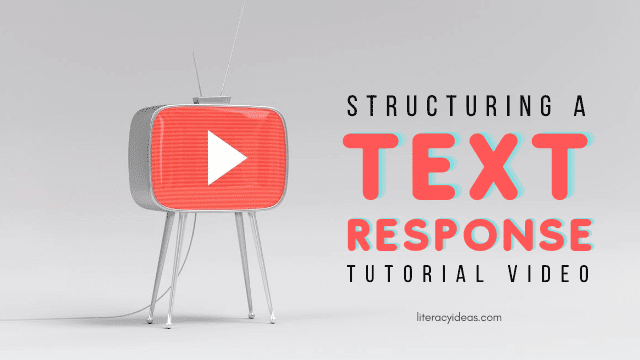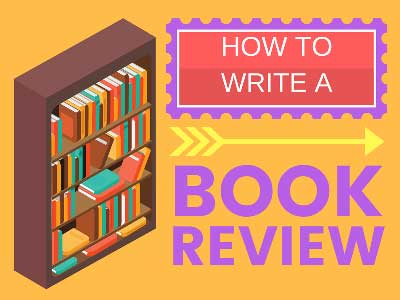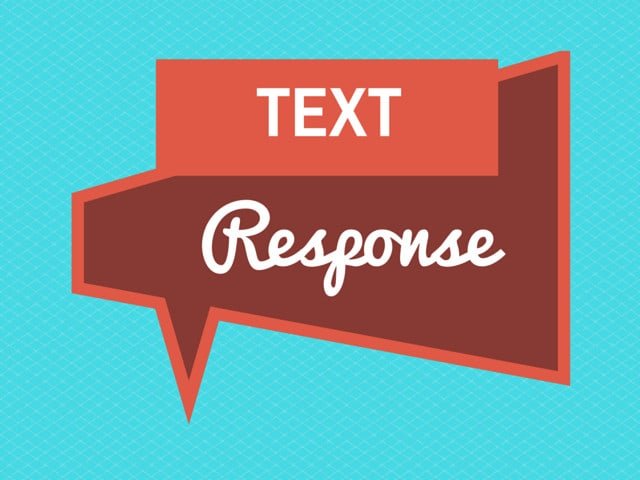
WHAT IS A TEXT RESPONSE?

In this guide, we will cover everything you need to know about writing a text response. Let’s start at the beginning.
A text response is a style of writing in which you are sharing your reaction to something. It is an opportunity to let the world know how you feel about something.
A text response can also be referred to as a reader response which is accurate, but you may also confuse them with a literacy narrative. This is not an accurate comparison, as a literacy narrative is more an assessment of how you became literate. In contrast, a text response is a specific response to a specific text.
A text response is specifically a response to a book you have read. Still, it can also be a response to a film you have just seen, a game you have been playing, or for more mature students; it could be a response to a decision the government is making that affects you or your community that you have read from a newspaper or website.
When writing a response, it is vital that you get the following points across to your audience.
- How do you feel about what you are reading / saw / heard?
- What do you agree or disagree with?
- Can you identify with the situation?
- What would be the best way to evaluate the story?
Some teachers get confused between a book review and a text response. Whilst they do share common elements, they are unique genres. Be sure to read our complete guide to writing a book review for further clarification.
WHAT IS THE PURPOSE OF A TEXT RESPONSE?
Often when we talk about the development of language skills, it is useful to discuss things in terms of four distinct areas. These are commonly grouped into the two active areas of speaking and writing and the two so-called passive areas of listening and reading. Learning to write a text response bridges this gap as it requires our students to not only develop high-level writing skills but also to consider reading as much more than a mere passive activity.
Writing a text response hones the student’s critical thinking skills and ability to express their thoughts in writing. It gives students an opportunity to engage in reading as an active exercise, rather than something that is analogous to watching TV!
A COMPLETE TEXT RESPONSE BUNDLE FOR STUDENTS
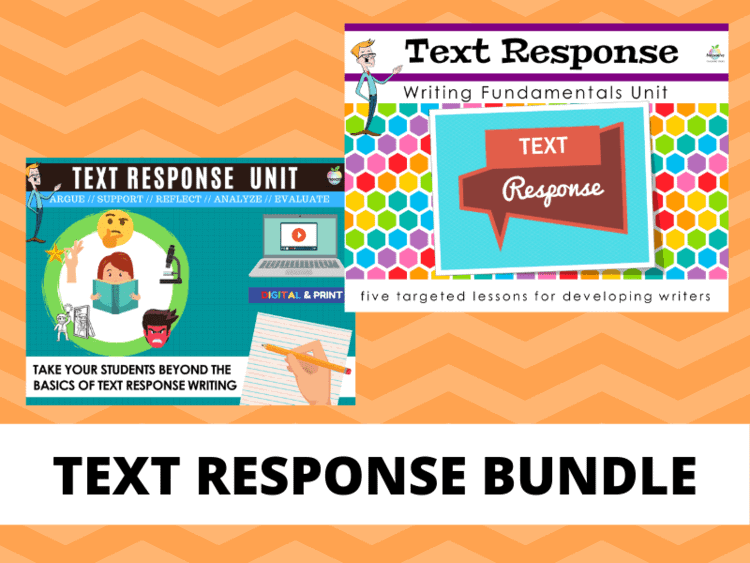
2 in-depth units for students and teachers to work on as a class or independently. Packed with teaching resources and lesson ideas.
160 PAGES of high-quality teaching units for all ages and abilities. NO PREPARATION IS REQUIRED. DIGITAL and PRINT to DOWNLOAD NOW.
TEXT RESPONSE STRUCTURE
KEEP IT FORMAL This is a calculated and considered response to what you have read or observed.
USE EVIDENCE Frequently refer to the text as evidence when having an opinion. It becomes the reference point for all your insights within your text response.
HAVE AN OPINION This is not a recount. This is your OPINION on what the author or film producer has created. Don’t shy away from that.
TENSE & STYLE Can be written in either past or present tense. Feel free to use your own style and language but remember to keep it formal.
TEXT RESPONSE FEATURES
YES or NO? Essentially you are making a recommendation. Ensure your audience know where you sit.
LET US INSIDE YOUR MIND How did it make you feel? What did you learn from it? Did you engage with the characters?
SHOW SOME BALANCE Even if you passionately loved or hated the text your audience will view you as biased if you solely focus on one angle. A little balance will give you credibility.
GETTING STARTED: THE PREWRITING STAGE OF A TEXT RESPONSE
As with much of the formal school experience, students can greatly benefit from undertaking a methodical approach in their work. The following process outlines step-by-step how students can best approach writing their text responses in the beginning.
The keyword in the phrase writing a text response is not writing but response. The whole thing starts with the reading and how the student considers the text they are engaging with. Whether the text they are being asked to respond to is an unseen piece in an exam situation or a piece of coursework based on something studied over a semester, the structure remains the same. This is true, too, regardless of age and ability level. Younger students should be taught to approach writing a text response using the same concepts but in a simplified and more scaffolded manner.
Read for Understanding:
Students should read the text they are responding to initially for a basic comprehension of what the text is about. They should read to identify common themes and narrative devices that will serve to answer the question. Often, the question will demand that the student consider and explain the author’s use of a specific literary device or how that literary device develops a central idea and the author’s purpose. In preparing our students to write competent text responses they must first be familiar with the literary devices and conventions that they will be asked to discuss.
Students may instinctively know what they like to read, but what is often not instinctive is the expressing of why they like to read it. They may acknowledge that the writing they are reading is of a high quality, or not as the case may be, but they may lack the vocabulary to express why the writing is successful or unsuccessful. Take the opportunity in class when reading, regardless of the genre, to point out literary devices, techniques, and stylistic considerations that will help your students when it comes to writing a text response.
As humans, we are hardwired to understand the world around us in terms of the stories we tell ourselves and others. We do this by employing comparisons and drawing parallels, we play with words in our everyday use of idiom and metaphor, alliteration and rhyme. Encourage students to keep an ear out for these techniques in the music they listen to, the comics they read, and the TV they watch. Even in the advertising they are exposed to.

Be sure too to offer your students opportunities to practice writing their own metaphors, similes, alliterative sentences etc. There is no better way to internalize an understanding of these literary techniques than by having a go at writing them yourself. And, it doesn’t have to be a dry academic exercise, it can be a lot of fun too.
Teaching alliteration? Have the students come up with their own tongue twisters. Want them to grasp simile? Have them produce Not! similes, for example, give them an adjective such as ‘cuddly’. Tell them you want them to write a simile using the simile structure employing ‘as’. Tell them too they must use the word ‘cuddly’ about someone who is not cuddly at all. Offer them the example He is as cuddly as a cactus to get the ball rolling. They can do this for any adjective and they will often achieve hilarious results!
Read Directions Carefully:
It should go without saying to read the directions carefully, but experience teaches us otherwise! Often it is not the best writers among our students who receive the best grades, but those who diligently respond to the directions of the task that has been set. Students should be sure to check that they have read the directions for their text response question closely. Encourage them to underline the keywords and phrases. This will help them structure their responses and can also serve as a checklist for them to refer to when they have completed writing their text responses.
Have students pinpoint exactly what the question is asking them. For older or stronger students, these questions will likely comprise several parts. Have the student separate the question into these component parts and pinpoint exactly what each part is asking them for.
A good practice to ensure a student has adequately understood what a question is looking for is to ask the student to paraphrase that question in their own words. This can be done either orally or as a written exercise. This helpful activity will inform the student’s planning at the prewriting stage and, as mentioned, can provide a checklist when reviewing the answer at the end.
The Process:
- To ensure students fully understand the question, have them underline or highlight keywords in the sentence or question. Distribute thesauruses and have students find synonyms for the keywords that they have highlighted.
- Have them rewrite the question as a series of questions in their own words. This will allow the teacher to assess their understanding of what they are being asked to do. It can also serve as a structured plan for writing their response.
- Allow some time for students to discuss the question together, either in small groups or with talking partners. After the allotted time, students must decide on a yes, no, or maybe response to the central question.
- Their response to Step 3 above will formulate their contention, which will serve as the driving force behind their text response as a whole.
- On their own, students brainstorm at least three arguments or reasons to support their contention.
- For each of the reasons, students should refer to the text and choose the best evidence available in support of their contention.
- Students should not be overly concerned with forming a logical order for their notes gathered so far. This activity aims to let ideas flow freely and capture them on paper.
When completed, it is at this point that they are ready to begin the writing process in earnest.
HOW TO WRITE A TEXT RESPONSE
As with writing in many other genres, it is helpful to think of the text response in terms of a three-part text response essay structure. It is a simple process of learning how to write a response paragraph and then organizing them into the ubiquitous beginning, middle, and end (or intro, body, and conclusion) that we drill into our students will serve us well again. Let’s take a look:
The Introduction:
The first paragraph in our students’ text responses should contain the essential information about the text that will orientate the reader to what is being discussed. Information such as the author, the book’s title or extract, and a general statement or two about the content will provide the reader with some context for the discussion.
The SOAPSTONE acronym is useful when considering which information is essential to include in the intro: Speaker, Occasion, Audience, Purpose, Subject, and TONE. Students should reflect on which aspects should be addressed in the introductory paragraph. The genre of the text will largely determine which of these should be included and which are left out. However, it is important the student does not get too bogged down at this stage; these orientation sentences usually require only three or four sentences in total.
Be sure to check out our own complete guide to writing perfect paragraphs here.
The tone of a text response should be such that it assumes the reader does not understand the text that the writer does. It is useful to tell them here to picture one person in their life they are writing to. Someone that would not be familiar with the text, perhaps a family member that they are explaining what they read. Remind them, though, the language should be formal too.
Once the student has established some context in the reader’s mind, they will need to address the central idea forming the ‘eye of the storm’ of their argument.

The Body:
When learning how to write a text response body paragraph, one of the most common pitfalls students fall into is engaging in a straightforward retelling of the text. Discussion of the text is the name of the game here. Students must get into the text and express their opinions on what they find there. It is quickly apparent when reading a student’s response when they are merely engaging in a retelling and delivering a thoughtful response. Be sure students are aware of the fact that this fools nobody!
The notes students have made in the prewriting stages will be extremely useful here. Each of the arguments or reasons they have produced to support their contention will form the basis for a body paragraph. The TEEL acronym is useful here:
Topic Sentence: Students should begin each paragraph with a topic sentence. This sentence introduces the point that will serve as the main idea of the paragraph – the central riff, if you like. It will engage directly with an aspect of the question or writing prompt.
Expand / Explain: The purpose of the next few sentences will be to narrow the focus of the topic sentence, often by referring to a specific character or event in the text and offering a further explanation of the central point being developed in the paragraph.
Evidence / Example: At this point in the paragraph, it is essential that the student makes close reference to the text to support the point they have been making. Having an opinion is great, but it must be based, and be shown to be based, on the actual text itself. Evidence will most often take the form of a quotation from the text – so make sure your students are comfortable with the mechanics of weaving quotations into their writing!
Link: The end of each body paragraph should link back to the student’s central contention. It restates the argument or reason outlined in the topic sentence but in the broader context of the central contention which usually is the yes, no, or maybe uncovered at the prewriting stage.
As the student moves through their essay, it is important that they reference the main theme of the text in each and every paragraph. The structure of the essay should illustrate an evolution of the student’s understanding of that theme.
References should be made to how the writer employs various literary techniques to construct meaning in his or her text. However, reference to literary techniques should not be made merely in passing but should be integrated into a discussion of the themes explored in the essay.
Writing a text response conclusion:

Writing the conclusion involves essentially restating the contentions made already, as well as summarizing the main points that were discussed. Though the conclusion will inevitably have much in common with the introduction, and some repetition is unavoidable, make sure students use different wording in their conclusion. The paraphrasing exercise in the prewriting stages may be helpful here.
Encourage students too to link back to their reasons and arguments developed to support their contention in the body paragraphs. The conclusion is no place to introduce new ideas or to ask rhetorical questions. It is the place for gathering up the strands of argument and making a statement about the relevance of the text in relation to the wider world.
TIPS FOR WRITING A GREAT TEXT RESPONSE
● In essays of this type, students should mostly write in the present tense.
● Encourage students to vary the length of their sentences to maintain the reader’s interest. But be careful too, students should avoid using overly long sentences as longer sentences can be more difficult to control. A good rule of thumb is that when expressing complex thoughts use several short sentences. Simpler thoughts can be expressed through longer, more complex sentences.
● Tie everything back to the question. The dissection of the question during the prewriting stage of the text response should remain at the forefront of the student’s mind at all times. If what the student writes doesn’t link back to the original question then it is deadwood and should be discarded.
● Writing a text response requires the student to analyze the text and responds personally with their own thoughts and opinions. They should not be afraid to make bold statements as long as they can make references to the text to support those statements.
● The prewriting stage is essential and should not be skipped. But, even with a well thought out prewriting session, where time allows, opportunities should be given for students to draft, redraft, and edit their writing.
We often teach our students that writing is about expressing our thoughts and ideas, but it is also about discovering what we think too.
TEXT RESPONSE TASK FOR STUDENTS
In a response paper, you are writing a formal assessment of what you have read or observed (this could be a film, a work of art, or a book), but you add your own personal reaction and impressions to the report.
The steps for completing a reaction or response paper are:
- Observe or read the piece for an initial understanding
- Record your thoughts and impressions in notes
- Develop a collection of thoughts and insights from
- Write an outline
- Construct your essay
Once you have established an outline for your paper, you’ll need to respond using the basic elements of every strong essay, a strong introductory statement.
In the case of a reaction paper, the first sentence should contain the title of the object to which you are responding and the name of the author/creator/publisher
The last sentence of your introductory paragraph should contain your stance or position on the subject you are writing about.
There’s no need to feel shy about expressing your own opinion in a response, even though it may seem strange to write “I feel” or “I believe” in an essay.
USEFUL STATEMENTS TO INCLUDE IN A TEXT RESPONSE
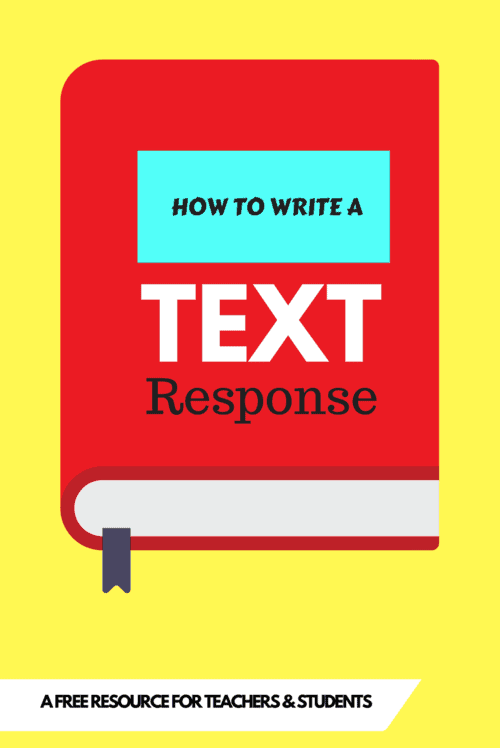
- I felt that
- In my opinion
- The reader can conclude that
- The author seems to
- I did not like
- The images seemed to
- The author was [was not] successful in making me feel
- I was especially moved by
- I didn’t get the connection between
- It was clear that the artist was trying to
- The sound track seemed too
- My favorite part was…because
Teaching Resources
Use our resources and tools to improve your student’s writing skills through proven teaching strategies.
TEXT RESPONSE GRAPHIC ORGANIZER
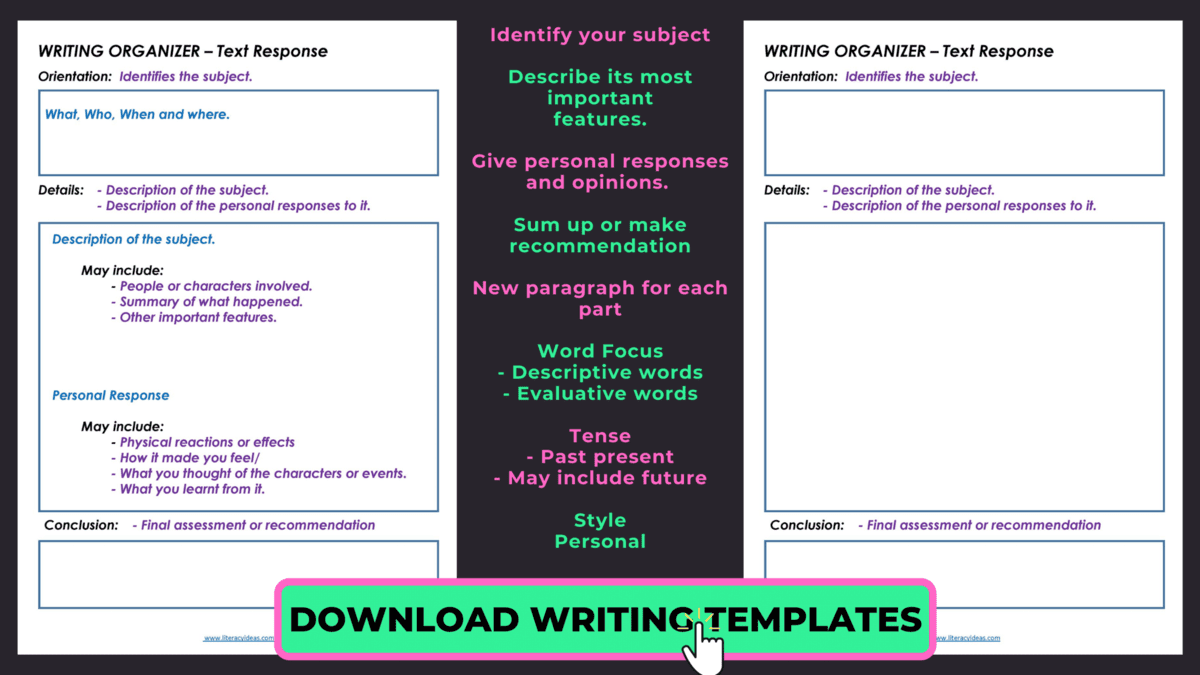
TEXT RESPONSE WRITING CHECKLIST & RUBRIC BUNDLE
⭐⭐⭐⭐⭐ (92 Reviews)





